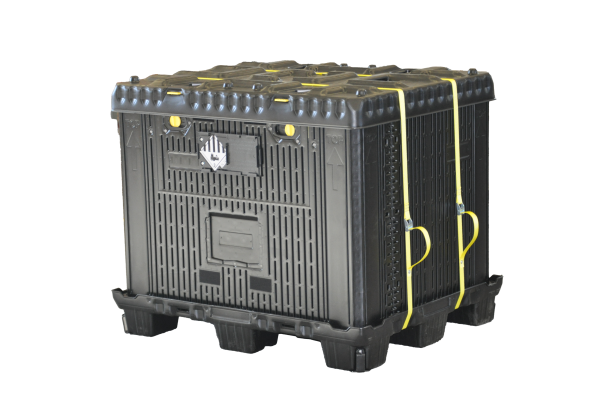- Article no: GENVG2J790S

Questions about the article?
Our staff member Petra Fürbeck is happy to help you:
+49 (0) 7151 - 256 4817 or info@lion-care.com
| Handling the filling material: | without filling material, Filling material in cushions, Filling material around inserts |
| max. gross mass: | 850 kg |
| Empty weight: | 57 kg |
| Material name: | high-density polyethylene (HDPE) |
| Volume: | 790 liters |
| Packaging group: | Packaging group II |
| Packaging instructions according to ADR: | LP 903, LP 904, LP 905 |
| ADR special provision: | SP 310, SP 376, SP 377 |
| UN packaging code: | UN 50H/X/mmyy/CZ/CIM10523/SÖHGEN 1530/850 |
| Areas of application: | defective batteries, Transportation of EOL lithium-ion batteries, Waste disposal, PowerTools, Power tool batteries, Garden tool batteries, Prototypes, Garden tool batteries, Model batteries, E-bike batteries, Recycling centers, fire-protected storage, Transport of rechargeable batteries, Transportation, Storage |
| External dimensions: | 1200 x 1000 x 1000 mm |
| Filling material: | without filling material, E-glass fiber needle mats, PyroBubbles® |
| Internal dimensions: | 1092 x 892 x 812 mm |
The GENIUS FLEX-BOX 790 foldable storage and transport container presented here offers an ideal solution for users looking for a reliable method of safely transporting or storing lithium batteries/lithium-ion batteries in accordance with the latest standards.
The properties, packaging instructions, approvals and ADR special regulations differ depending on the variant selected.
Size and capacity of the storage and transport container
The foldable GENIUS FLEX-BOX 790 storage & transport box has a volume of 790 liters and can hold a payload of 793 kg. The empty weight is 57 kg.
The FLEX-BOX 790 has external dimensions of 1200 x 1000 x 1000 mm and internal dimensions of 1092 x 892 x 812 mm (length x width x height). The container is made of high-density polyethylene (HDPE).
Certification and guidelines
Lithium batteries fall into dangerous goods class 9, which means that the goods pose a risk to the environment during transportation that should not be underestimated. Numerous specifications and guidelines must therefore be observed when transporting lithium batteries.
Certified for packaging group II
The containers in the FLEX-BOX series meet the requirements of packaging group II, which means that substances with a medium hazard potential may be transported in them. To achieve this classification, drop tests from 1.2 m must be passed.
Different properties and filling materials
Height of the folded box
The "Basic" version impresses with a folded height of 276 mm, which enables compact and space-saving storage. The "Advanced" and Premium versions impress with a folded height of 420 mm.
E-glass fiber needle mats and PyroBubbles provide additional protection
The Advanced version protects the contents from shocks and vibrations with E-glass fiber needle mats. This filler is non-flammable and non-electrically conductive. The "Premium" version is available for the highest safety requirements.
Filling material and safety features
No additional filling material is required for the "Basic" version. This option is ideal for transporting undamaged and non-defective batteries that do not require any special filling material in accordance with packaging regulation P 903. For increased safety, we recommend the "Advanced" variant, which is equipped with e-fiberglass needle mats. The Advanced variant can also be used to store or transport damaged and defective batteries and prototypes. For maximum safety and protection, we recommend the "Premium" version. Here, e-fiberglass needle mats are used in combination with PyroBubbles cushions. The box is filled with the fire protection agent PyroBubbles®, which forms a closed and thermally insulating layer around a fire source. The PyroBubbles provide an additional fire protection function and contribute to safety, especially when storing or transporting lithium batteries or lithium-ion batteries.
Direct comparison of the variants
| Variant 1 Basic | Variant 2 Advanced | Variant 3 Premium | |
|---|---|---|---|
| Volume / max. payload | 790 l / 793 kg | 790 l / 793 kg | 790 l / 793 kg |
| External dimensions in mm | 1200 x 1000 x 1000 | 1200 x 1000 x 1000 | 1200 x 1000 x 1000 |
| Internal dimensions in mm | 1092 x 892 x 812 | 1092 x 892 x 812 | 1092 x 892 x 812 |
| Empty weight / TARE | 57 kg | 57 kg | 57 kg |
| Material | HDPE rigid plastic | HDPE rigid plastic | HDPE rigid plastic |
| Foldable | Yes | Yes | Yes |
| Height folded | 276 mm | 420 mm | 420 mm |
| Filling material | not necessary | E-glass fiber needle mats | E-glass fiber needle mats incl. PyroBubbles cushion |
| Active fire retardant with filter effect | No | No | PyroBubbles cushion with filter effect for higher protection |
| Areas of application | Storage & transportation of lithium-ion batteries 3480, 3481 | Storage & transportation of lithium-ion batteries 3480, 3481 | Storage & transportation of lithium-ion batteries 3480, 3481 |
| Approved for the following battery types | For undamaged and non-defective batteries | For damaged and defective batteries, prototypes | For damaged and defective batteries, prototypes |
| UN packaging code | UN 50H/X/mmyy/CZ/CIM10523/SÖHGEN 1530/850 | UN 50H/X/mmyy/CZ/CIM10523/SÖHGEN 1530/850 | UN 50H/X/mmyy/CZ/CIM10523/SÖHGEN 1530/850 |
| Type approval | Packing group II | Packing group II | Packing group II |
| Packaging instructions | LP903 | LP903, LP904, LP905 | LP903, LP904, LP905 |
| ADR special regulations | _ | SV 310, SV376, SV636 | SV 310, SV376, SV636 |
| Stackability | Yes | Yes | Yes |
| Additional tension belts | 2 pcs | 2 pcs | 2 pcs |
| Can be driven under (pallet truck) | Yes | Yes | Yes |
Future-oriented
Lithium-ion batteries will be indispensable in all industrial applications in the coming years. However, if used improperly, batteries can pose a potential risk during production, storage and transportation that should not be underestimated. By purchasing these boxes, you protect yourself against major financial losses right from the start. International customers from the automotive and energy supply sectors, among others, rely on this proven technology.
In use for you
If you have any questions, please do not hesitate to contact us. We look forward to hearing from you!
| Suitable for critically defective?: | No |
| Filling material supplied: | without filling material |
| Handling the filling material: | without filling material, Filling material in cushions, Filling material around inserts |
| max. gross mass: | 850 kg |
| Empty weight: | 57 kg |
| Type: | Storage box |
| Material: | Plastic |
| Type of packaging: | Large hazardous goods packaging (LP) |
| Volume: | > 600 l |
| Coding: | 50H |
| Material name: | high-density polyethylene (HDPE) |
| Volume: | 790 liters |
| Packaging group: | Packaging group II |
| Packaging instructions according to ADR: | LP 903, LP 904, LP 905 |
| ADR special provision: | SP 310, SP 376, SP 377 |
| UN packaging code: | UN 50H/X/mmyy/CZ/CIM10523/SÖHGEN 1530/850 |
| Areas of application: | defective batteries, Transportation of EOL lithium-ion batteries, Waste disposal, PowerTools, Power tool batteries, Garden tool batteries, Prototypes, Garden tool batteries, Model batteries, E-bike batteries, Recycling centers, fire-protected storage, Transport of rechargeable batteries, Transportation, Storage |
| External dimensions: | 1200 x 1000 x 1000 mm |
| Filling material: | without filling material, E-glass fiber needle mats, PyroBubbles® |
| Internal dimensions: | 1092 x 892 x 812 mm |
That depends on various factors that need to be considered:
- size of the battery(ies)
- condition (e.g. non-critical, defective, critically defective or prototype)
- power
Transport boxes are available in many different sizes and specifications. The packaging group for which the box is suitable is indicated for each product.
Find out more in our blog article:
https://www.lion-care.com/aktuelles/blog/transportvorschriften-regeln-und-sicherheitsmassnahmen
Even if the batteries are not critical, remember to protect them from shocks and to order appropriate filling material if it is not already included in the box.
Yes. Should a battery reach a critical state and cause a fire, separating the batteries will prevent the fire from spreading and multiplying.
Generally, the insulation and protection material should line all sides of the container. The batteries are stored between individual layers.
We also have containers in our program that already have the protective material integrated into the outer wall. No further protective layer is necessary here.
The technical principles for storage and transportation solutions are very similar. The transport boxes are also subjected to extensive tests in accordance with ADR (drop test, fire test, etc.) to confirm compliance with the ADR regulations. The packaging regulations are extensive and regulated by law.
There are currently no comparable regulations for storage. Nevertheless, manufacturers of storage boxes regularly carry out appropriate tests.
The right container depends on the type and size of the battery to be shipped or stored.
If you want to learn more about battery storage and transportation, you will find the answers in our blog articles:
https://www.lion-care.com/aktuelles/blog/transportvorschriften-regeln-und-sicherheitsmassnahmen
https://www.lion-care.com/aktuelles/blog/lithium-ionen-akkus-sicherer-umgang-und-richtige-lagerung
The transportation of batteries is subject to ADR regulations.
The number, size and weight, energy density and condition of the batteries are crucial parameters for finding a suitable transport container for lithium-ion batteries. The selection process is complex and should be carried out by appropriately trained personnel. We have a trained hazardous materials officer on our team. Please feel free to contact us.
Plastic containers are cheaper but not as durable as metal containers. They are suitable, for example, for non-critical batteries, defective batteries, prototypes and end-of-life batteries. They can be used for both storage and transportation.
Metal containers are required, for example, when dealing with critically defective batteries.
The exact packaging instructions for these cases can be found in the ADR or by consulting a certified hazardous materials specialist.
To date, there are no legal requirements for the storage of lithium-ion batteries, which does not mean that they should be stored without suitable protective measures.
It is best to check with your insurer to find out which measures they recognize as suitable in the event of a claim.
For example, a suitable box could already be recognized as spatial separation.
A rough overview can be found in this VDS publication from the GDV:
https://shop. vds.de/download/vds-3103/ccb1d439-ad9d-47cb-a2b1-ace23e155610
Please also read our blog article on this topic:
https://www.lion-care.com/aktuelles/blog/lithium-ionen-akkus-sicherer-umgang-und-richtige-lagerung














